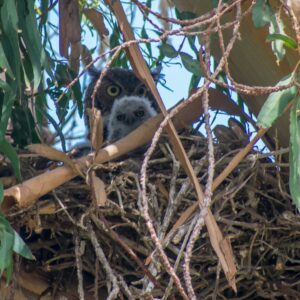Owls Well That Ends Well
From the field thi s month we are highlighting an excellent excerpt from the Crystal Cōver, a newsletter written each month by California State Parks interpretive naturalist Winter Bonnin.
s month we are highlighting an excellent excerpt from the Crystal Cōver, a newsletter written each month by California State Parks interpretive naturalist Winter Bonnin.
I was walking out of the tunnel entering the Historic District and heard a raucous call from one of the eucalyptus trees along the walkway. The alarmed creature was very loud, incessant and clearly disturbed. It sounded like a monkey, but unless someone released a pet monkey into the park, I knew it couldn’t be. Finally, I saw a large animal thrashing in the leaves of the tree then fly off and land on a power pole. The sound came from a Cooper’s Hawk who was apparently aggrieved by the presence of two Great Horned Owls (GHO) who had presumably wrested control of its territory. The hawk flew away after awhile, but the owls perched motionless and nearly invisible on a low branch hidden by foliage for the entire day.
The indomitable Great Horned Owl typically usurps nests built by other species in whatever tree is available. They are monogamous birds who often remain on the same territory year round. Pairs, who may stay together for life, lay 1-4 eggs in late January or early February. Female GHO sit on the nest and incubate their eggs for up to 37 days while the male hunts and delivers meals. When the babies hatch they are covered with white downy plumage and stay in the nesting area for up to six weeks. Fledglings remain in close company for several weeks, and although the parent owls often roost nearby, they move to a different tree in order to avoid the unrelenting begging from their off spring. In fact, fledged owls remain with parents throughout most of the summer and may be seen begging for food into October, four to five months after leaving the nest. In all my years I don’t recall ever having seen nesting owls in the park and so I do hope they are successful.
Since this article appeared in the Cōver Newsletter, the Great Horned Owls have successfully produced two adorable owlets! Owl the best to these new birds of prey.
If you are interested in reading more the Crystal Cover can be found Crystalcovestatepark.org under the park info tab.
